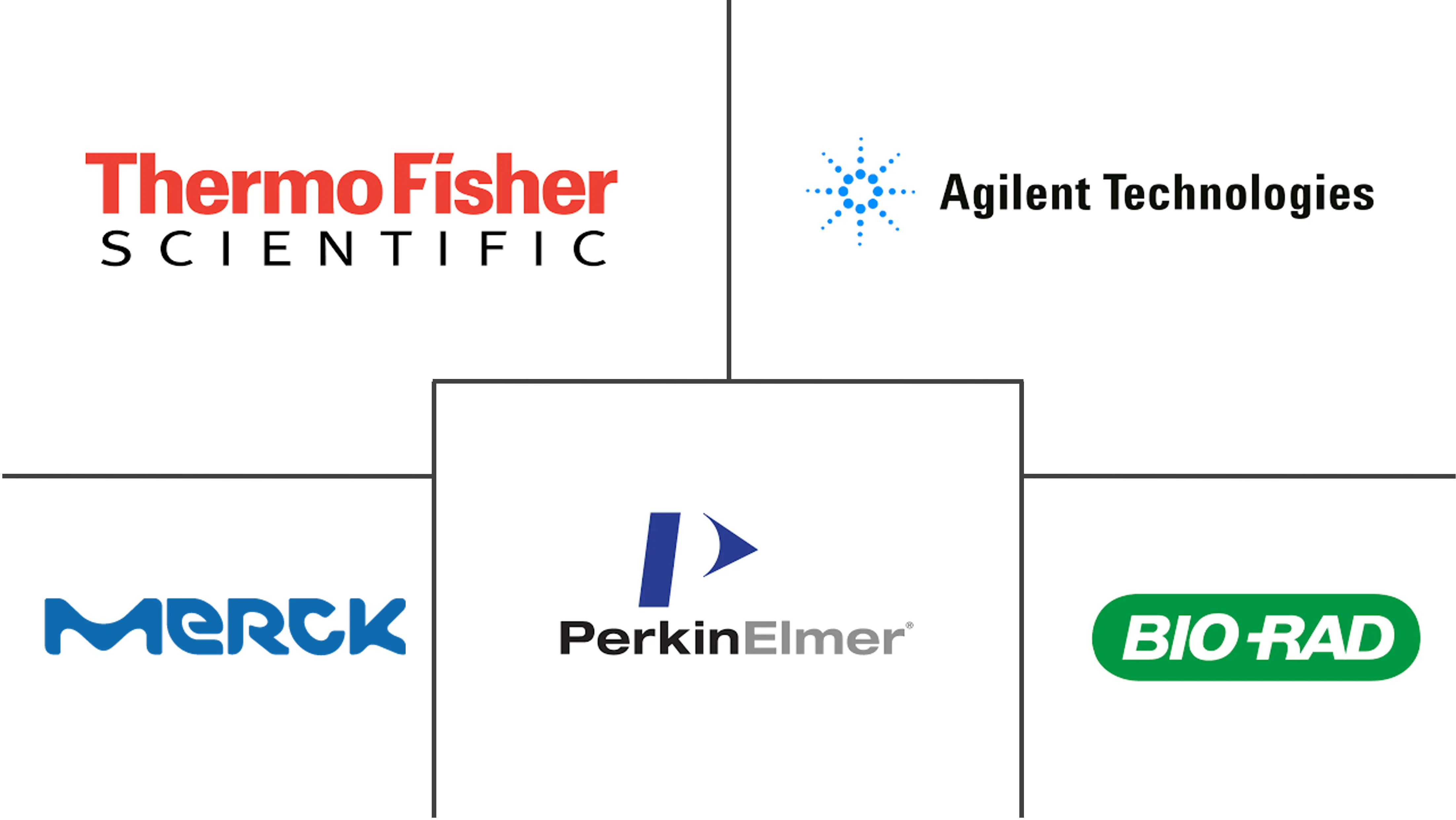High-throughput Screening Market Size and Share
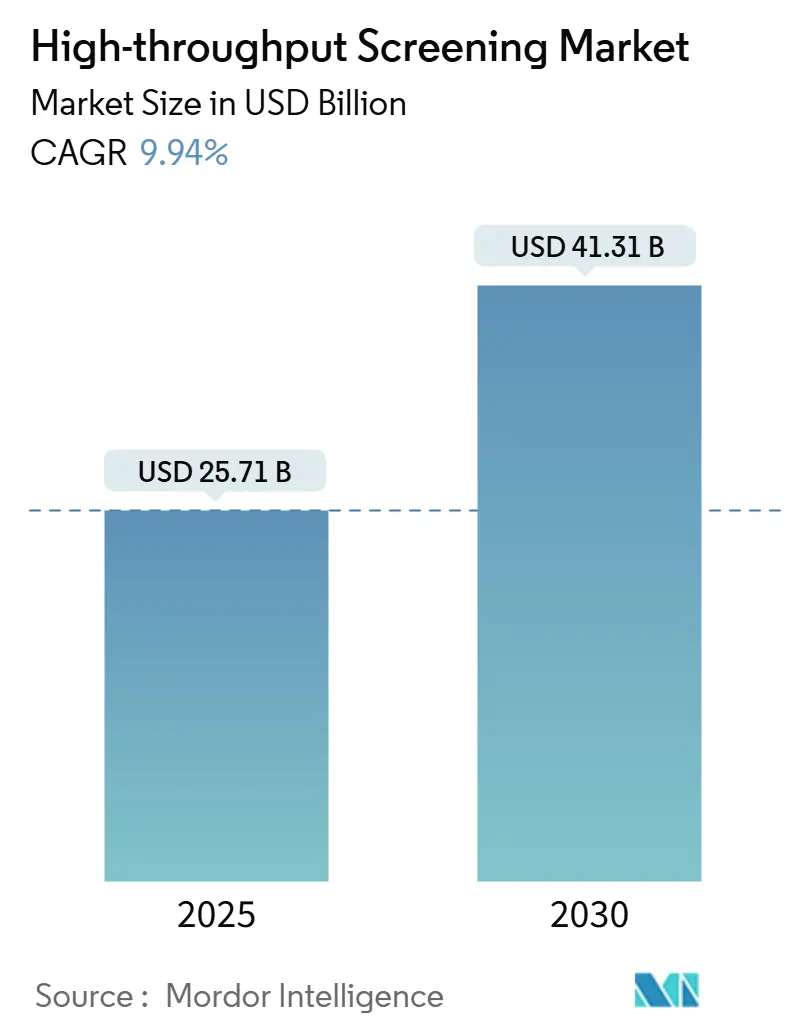
High-throughput Screening Market Analysis by Mordor Intelligence
The High-throughput Screening Market size is estimated at USD 25.71 billion in 2025, and is expected to reach USD 41.31 billion by 2030, at a CAGR of 9.94% during the forecast period (2025-2030).
This expansion is anchored in widespread adoption of AI-enabled automation that compresses drug-discovery timelines and trims per-assay costs by 40%. Growing demand for physiologically relevant 3-D assays, rising R&D budgets focused on precision medicine, and strategic outsourcing to contract development and manufacturing organizations (CDMOs) reinforce the upward trajectory. Intensifying competition among integrated platform providers fosters rapid technology refresh cycles, while venture investment in microfluidic ultra-high-throughput screening (uHTS) platforms fuels product innovation. Regulatory encouragement of non-animal testing and sustainable laboratory practices adds momentum by redirecting capital toward advanced cell-based systems.
Key Report Takeaways
- By technology, cell-based assays led with 45.14% of high throughput screening market share in 2024; lab-on-a-chip and microfluidic platforms are projected to grow at a 10.69% CAGR to 2030.
- By application, primary and secondary screening accounted for 53.56% of the high throughput screening market size in 2024, while toxicology and ADME applications are set to expand at a 13.82% CAGR through 2030.
- By product & service, reagents, kits, and consumables commanded 42.19% revenue share in 2024; services are advancing at a 15.56% CAGR through 2030.
- By end-user, pharmaceutical and biotech companies held 48.94% high throughput screening market share in 2024; CDMOs are the fastest growing, registering a 12.16% CAGR to 2030.
- By geography, North America retained 39.81% revenue share in 2024, whereas Asia-Pacific is forecast to progress at a 14.16% CAGR to 2030.
Global High-throughput Screening Market Trends and Insights
Drivers Impact Analysis
| Driver | (~) % Impact on CAGR Forecast | Geographic Relevance | Impact Timeline |
|---|---|---|---|
| Advances in robotic liquid-handling & imaging systems | +2.1% | Global, North America & EU lead adoption | Medium term (2-4 years) |
| Rising pharma/biotech R&D spending & pipeline growth | +1.8% | Global, concentrated in major pharma hubs | Long term (≥ 4 years) |
| Adoption of physiologically relevant cell-based & 3-D assays | +1.5% | North America & EU core, expanding to APAC | Medium term (2-4 years) |
| AI/ML in-silico triage shrinking wet-lab library size | +1.3% | Global, Silicon Valley & Boston clusters lead | Short term (≤ 2 years) |
| Venture-Backed Microfluidic uHTS Platforms | +0.9% | North America & EU, emerging in APAC | Medium term (2-4 years) |
| Rising CDMOs Bundling HTS In Integrated Discovery Contracts | +1.2% | Global, with Asia-Pacific showing fastest adoption | Long term (≥ 4 years) |
| Source: Mordor Intelligence | |||
Advances in Robotic Liquid-Handling & Imaging Systems
Breakthroughs in adaptive robotics are elevating throughput and reproducibility across the high throughput screening market. Computer-vision modules now guide pipetting accuracy in real time, cutting experimental variability by 85% compared with manual workflows.[1]arXiv preprint, “Real-Time Vision-Guided Pipetting,” arxiv.org Integrated AI detection algorithms process more than 80 slides per hour, lifting the ceiling for high-content imaging throughput.[2]Evident Scientific, “High-Content Imaging Productivity,” evidentscientific.com Dual-interface programming lets chemists configure complex workflows without specialist coding, broadening user access. Capital investments exceeding USD 2 million per workcell remain justified as return-on-investment profiles improve with volumes above 100,000 compounds annually. The result is a self-reinforcing cycle of platform upgrades that propels the high throughput screening market toward greater scale, speed, and data quality.
Rising Pharma/Biotech R&D Spending & Pipeline Growth
Expanded R&D budgets dedicated to precision medicine funnel capital into screening platforms that integrate computational biology with automated experimentation. AI-powered discovery has shortened candidate identification from six years to under 18 months, attracting venture flows to companies such as Recursion Pharmaceuticals, which progressed two AI-discovered oncology drugs to clinical trials in early 2025.[3]Recursion Pharmaceuticals, “Advancement of AI-Discovered Oncology Drugs,” recursion.com The multiplier effect between rising budgets and algorithmic efficiency positions early-stage screening as a strategic lever for risk mitigation and timeline compression. Oncology and rare-disease pipelines especially benefit, as rapid compound triage supports combination-therapy exploration and personalized regimens.
Adoption of Physiologically Relevant Cell-Based & 3-D Assays
Commercial 3-D organoid and organ-on-chip systems increasingly replicate human tissue physiology, boosting predictive accuracy and lowering late-stage attrition. Organ-on-chip devices model drug-metabolism pathways that standard 2-D cultures cannot capture, addressing the 90% clinical-trial failure rate linked to inadequate preclinical models. Advanced bioreactors optimize nutrient delivery, while microfluidic chips create physiological microenvironments that assess transport across biological barriers. AI-guided stem-cell manufacturing scales production of induced pluripotent stem cells, opening new windows for disease modeling and regenerative toxicology screens. These developments converge to strengthen the high throughput screening market’s value proposition in translational research.
AI/ML In-Silico Triage Shrinking Wet-Lab Library Size
Virtual screening powered by hypergraph neural networks now predicts drug–target interactions with experimental-level fidelity, shrinking wet-lab libraries by up to 80%. Generative models suggest novel chemotypes that satisfy multi-parameter optimization, widening accessible chemical space while cutting reagent costs. Language models trained on reaction data increasingly outperform human experts in retrosynthetic planning. Computational triage concentrates physical screening on top-ranked hits, improving cost efficiency and throughput, and reinforcing the appeal of integrated AI-HTS platforms to pharma and CDMO partners.
Restraints Impact Analysis
| Restraint | (~) % Impact on CAGR Forecast | Geographic Relevance | Impact Timeline |
|---|---|---|---|
| High capital expenditure for fully automated HTS workcells | -1.4% | Global, smaller biotech firms most affected | Medium term (2-4 years) |
| Shortage of skilled assay-automation specialists | -0.8% | North America & EU, emerging pressure in APAC | Long term (≥ 4 years) |
| Data-quality & reproducibility issues across labs | -0.6% | Global, standards vary by region | Short term (≤ 2 years) |
| Sustainability push against single-use 1,536-well plastics | -0.4% | EU spearheads; North America & APAC follow | Long term (≥ 4 years) |
| Source: Mordor Intelligence | |||
High Capital Expenditure for Fully Automated HTS Workcells
Initial outlays near USD 5 million, including software, validation, and training, create financial friction for smaller firms. Annual maintenance and licensing inflate operating budgets by 15-20%. Although total cost of ownership favors high-volume users, capital intensity delays adoption in cash-constrained organizations and sustains demand for outsourced services. Equipment-leasing and shared-facility models partially offset the barrier, yet the pace of technology obsolescence remains an enduring hurdle to rapid market penetration.
Shortage of Skilled Assay-Automation Specialists
Interdisciplinary expertise in biology, chemistry, robotics, and data science is scarce. Academic programs have lagged, prompting companies to establish internal training pipelines and partner with technical institutes. Talent shortfalls inflate wages and slow deployment timelines in the high throughput screening industry benchmark facilities. Remote diagnostics and AI-assisted troubleshooting extend expert reach, but on-site assay optimization still requires specialized staff, tempering near-term scaling ambitions.
Segment Analysis
By Technology: Cell-Based Platforms Drive Physiological Relevance
Cell-based assays held 45.14% high throughput screening market share in 2024, reflecting their capability to model complex signaling pathways and predict human efficacy more accurately than biochemical alternatives. The segment benefits from continual advances in fluorescent reporters, 3-D culture scaffolds, and label-free impedance technologies that capture subtle phenotypic shifts. The high throughput screening market size associated with lab-on-a-chip and microfluidic platforms is set to expand rapidly as 10.69% CAGR growth unlocks reagent savings and heightens assay sensitivity. Demand for ultra-high-throughput platforms remains steady among large pharmaceutical libraries, whereas label-free approaches attract safety-toxicology workflows seeking minimal assay interference.
The fusion of high-content imaging with AI-driven analytics magnifies data depth per screen, enabling phenotypic discovery that surfaces unexpected mechanisms of action. Organoid-based screening further differentiates compound responses by tissue microarchitecture, aiding oncology programs that require tumor-microenvironment fidelity. Together, these innovations fortify the cell-based segment’s leading revenue position and catalyze a pipeline of next-generation systems that sustain the high throughput screening market’s long-term expansion.
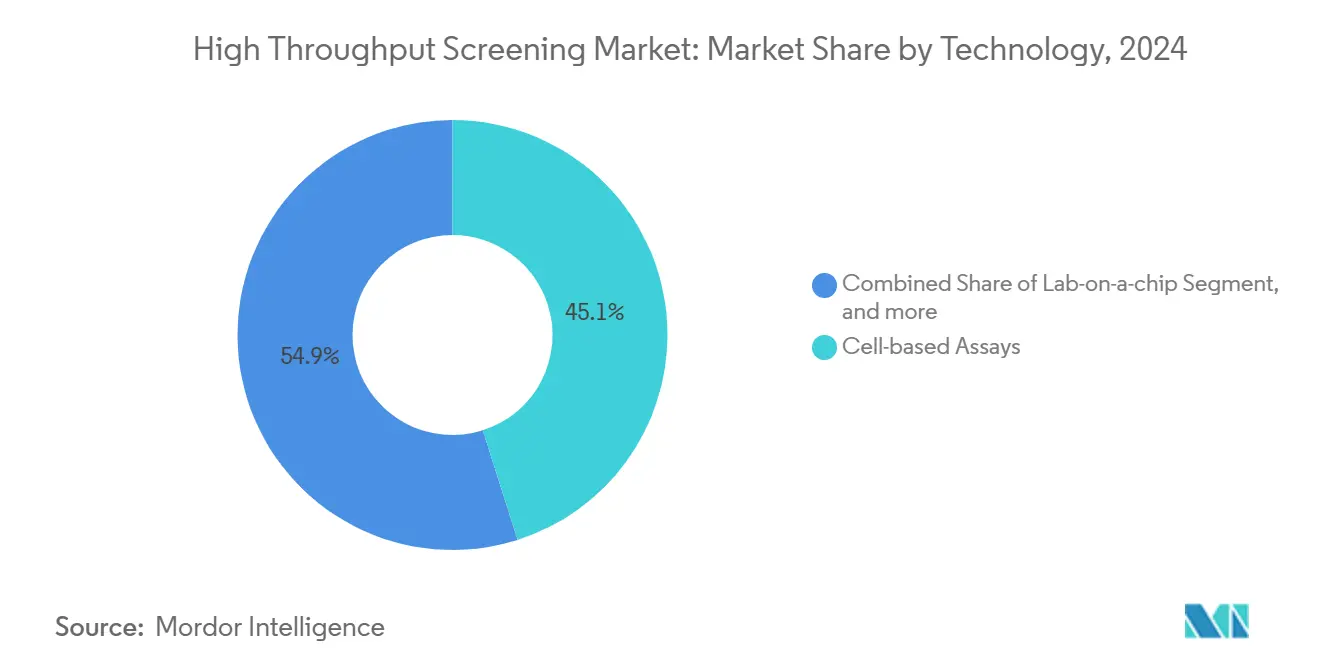
By Application: Primary Screening Dominance Masks Toxicology Surge
Primary and secondary screening applications contributed 53.56% of the high throughput screening market size in 2024, underscoring their foundational role in hit identification. Automated assay miniaturization and AI triage have accelerated sample throughput, aligning with discovery teams’ need for rapid lead selection. In contrast, toxicology and ADME workflows are poised for 13.82% CAGR through 2030 as global regulators press for non-animal safety data. The shift reflects an economic calculus wherein early safety interrogation minimizes late-stage attrition costs, a prime consideration for venture-backed programs operating on compressed timelines.
In vitro toxicology platforms now incorporate human-derived cell lines, organ-on-chip devices, and predictive AI models, offering 360-degree safety profiling that informs candidate prioritization. CRISPR-enabled target validation accelerates disease-gene linkage studies, while multiplexed biomarker readouts sharpen translational relevance. Collectively, these dynamics diversify revenue streams by balancing legacy high-volume screens with safety-centric assays that draw premium pricing, reinforcing stability across the high throughput screening market.
By Product & Service: Services Growth Signals Industry Transformation
Reagents, kits, and consumables maintained 42.19% revenue share in 2024, yet service-oriented offerings are forecast to outpace all other categories at a 15.56% CAGR. Pharmaceutical sponsors increasingly outsource early discovery to CDMOs that bundle screening, hit-to-lead optimization, and preclinical services in integrated contracts. Flexible engagement models appeal to asset-light strategies, enabling sponsors to align expenditure with milestone achievement and diversify program portfolios.
Instruments continue to drive replacement cycles as vendors embed AI analytics and cloud connectivity, but incremental hardware sales lag the rapid expansion of managed services. Software platforms deliver differentiating value through data harmonization and visualization, facilitating cross-site reproducibility and audit readiness. The synergistic effect of informatics and services elevates switching costs, deepening vendor–client partnerships and anchoring recurring revenue streams that uphold growth momentum in the high throughput screening market.
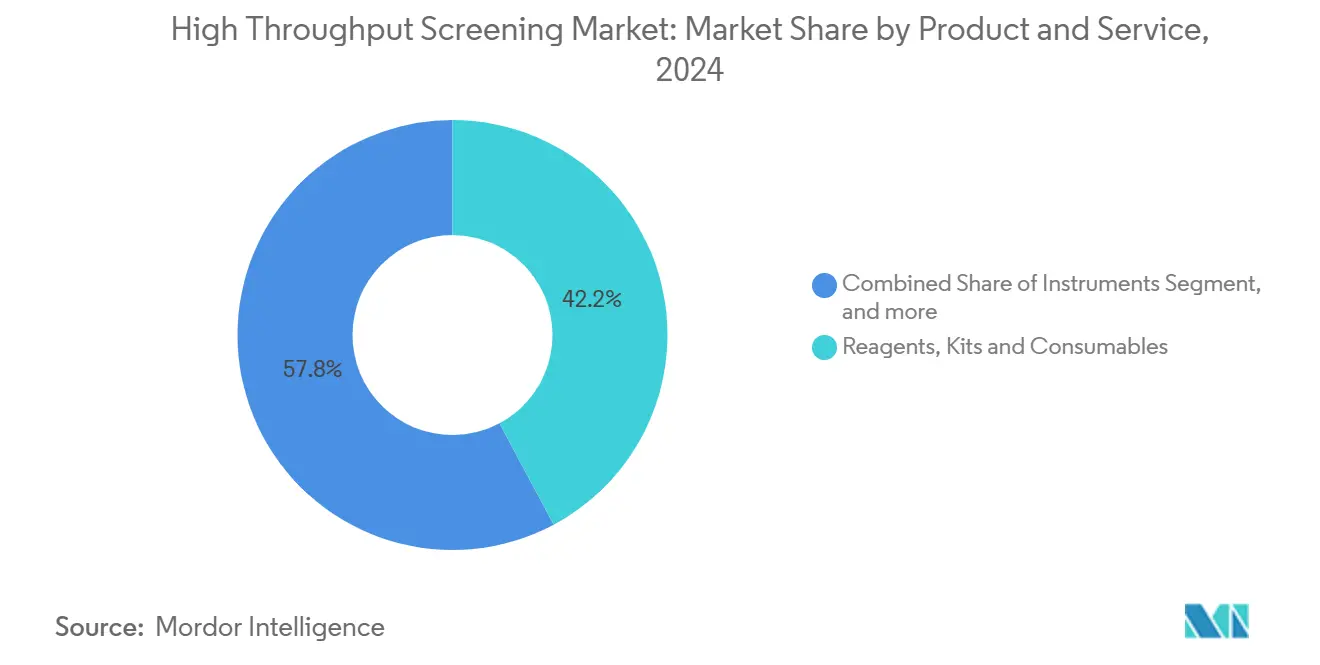
Note: Segment shares of all individual segments available upon report purchase
By End-User: CDMO Acceleration Reshapes Discovery Economics
Pharmaceutical and biotech companies controlled 48.94% high throughput screening market share in 2024, leveraging established infrastructure and compound libraries. However, CDMOs are expanding at 12.16% CAGR as they capitalize on economies of scale and consolidated expertise. Outsourcing mitigates fixed-cost burdens for sponsors and grants smaller firms access to high-capacity platforms without heavy capital commitments. Academic institutes provide foundational research and novel assay concepts yet command limited revenue influence relative to commercial actors.
Asia-Pacific CDMOs gain additional traction by coupling lower operating expenses with proximity to burgeoning biotech clusters. The acquisition of China’s Fengli Group by Barentz typifies strategic moves to bolster regional capabilities and integrate local talent pools. These developments collectively tilt discovery economics toward external providers, cementing CDMOs as pivotal growth engines within the high throughput screening market.
Geography Analysis
North America generated 39.81% revenue in 2024, sustained by mature pharmaceutical ecosystems, high adoption of AI-enabled automation, and robust venture capital participation. Expansive compound libraries and favorable reimbursement landscapes accelerate platform upgrades, anchoring region-wide demand. The high throughput screening market size in the United States benefits from strategic National Institutes of Health (NIH) grants that incentivize translational research partnerships between academia and industry.
Europe maintains steady growth through stringent quality standards and supportive regulatory frameworks that encourage 3-D cell culture adoption. Clusters in Germany, the Netherlands, and the Scandinavian countries champion sustainable laboratory initiatives, spurring investments in reusable microfluidic cartridges that dovetail with continental environmental goals. The regional market also attracts Horizon-Europe funding earmarked for next-generation toxicology.
Asia-Pacific is forecast to advance at a 14.16% CAGR, outpacing Western counterparts as China’s biotech sector experiences renewed capital inflows and supportive policy measures. A 60% biotech stock rally in 2025 outperformed AI sector indices, channeling investor confidence toward drug-discovery infrastructure. Licensing deals between Western majors and Asian biotech firms establish screening hubs that leverage competitive operating costs while adhering to international compliance standards. Rapid adoption of organ-on-chip and microfluidic technologies positions Asia to leapfrog legacy modalities, expanding the high throughput screening market’s geographic diversification.
Emerging markets in South America and the Middle East & Africa exhibit untapped potential. Brazil and the United Arab Emirates spearhead national innovation agendas that fund shared HTS facilities within biotechnology parks. Infrastructure limitations and regulatory variability presently temper adoption rates, yet global CDMO expansion into these regions sets the stage for technology transfer and local capacity building, offering a future lift to worldwide high throughput screening market penetration.
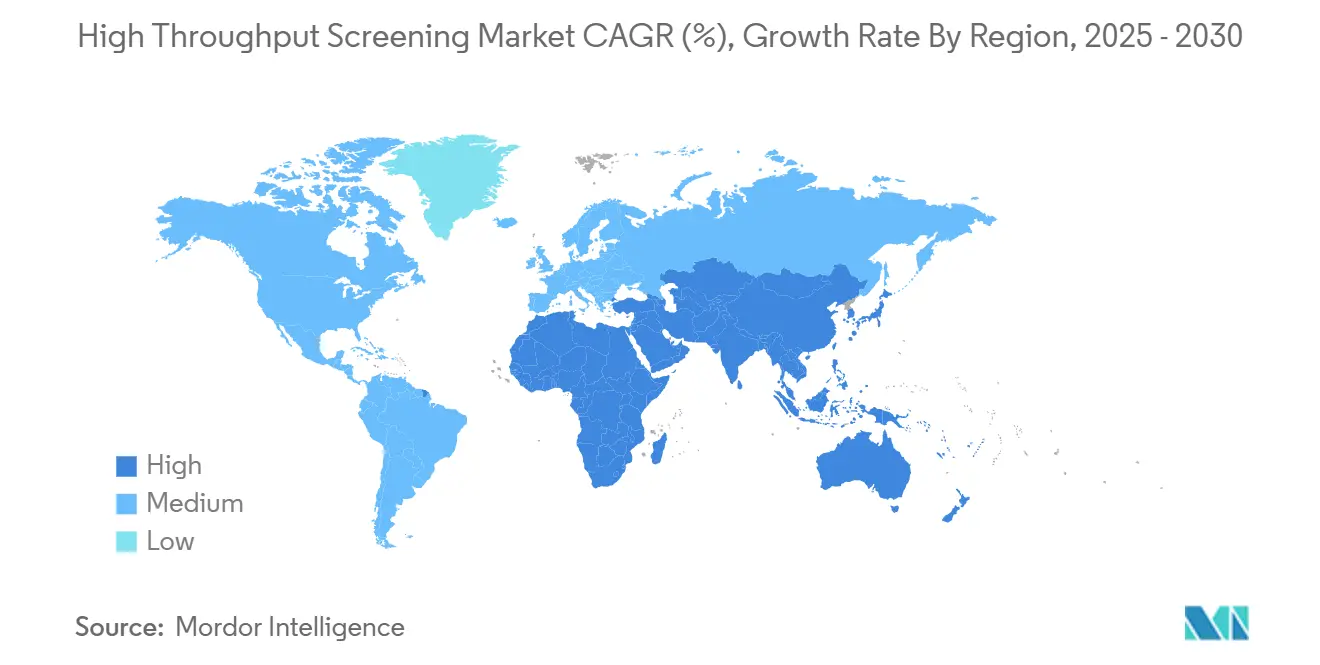
Competitive Landscape
The high throughput screening market demonstrates moderate consolidation, with leading vendors integrating instrumentation, software, and services into unified platforms that heighten switching costs. Top players differentiate through proprietary AI algorithms that dissect multiparametric imaging and biochemical data, furnishing clients with actionable insights. Strategic acquisitions of niche software startups and microfluidic innovators reinforce end-to-end capability, exemplified by Applied Industrial Technologies’ purchase of IRIS Factory Automation to extend material-handling proficiency.
Competitive intensity rises as venture-backed disruptors commercialize organ-on-chip and sustainable screening consumables. These challengers target white-space opportunities in regulatory-compliant plastics alternatives and spatial-biology integrations. Established vendors respond by forming ecosystem partnerships, sharing application program interfaces (APIs) that permit third-party analytics while retaining instrument lock-in.
Platform convergence is a defining strategic vector. Vendors embed cloud LIMS, digital twins, and augmented-reality maintenance support to deliver comprehensive laboratory operating systems. This breadth curtails price competition and secures multi-year service contracts, safeguarding revenue visibility in the high throughput screening market. Sustainability credentials and data-governance assurances increasingly influence procurement decisions, prompting incumbents to publish transparent environmental and cybersecurity benchmarks to preserve market leadership.
High-throughput Screening Industry Leaders
-
Bio-Rad Laboratories Inc.
-
PerkinElmer Inc.
-
Thermo Fisher Scientific Inc.
-
Merck KGaA
-
Agilent Technologies Inc.
- *Disclaimer: Major Players sorted in no particular order
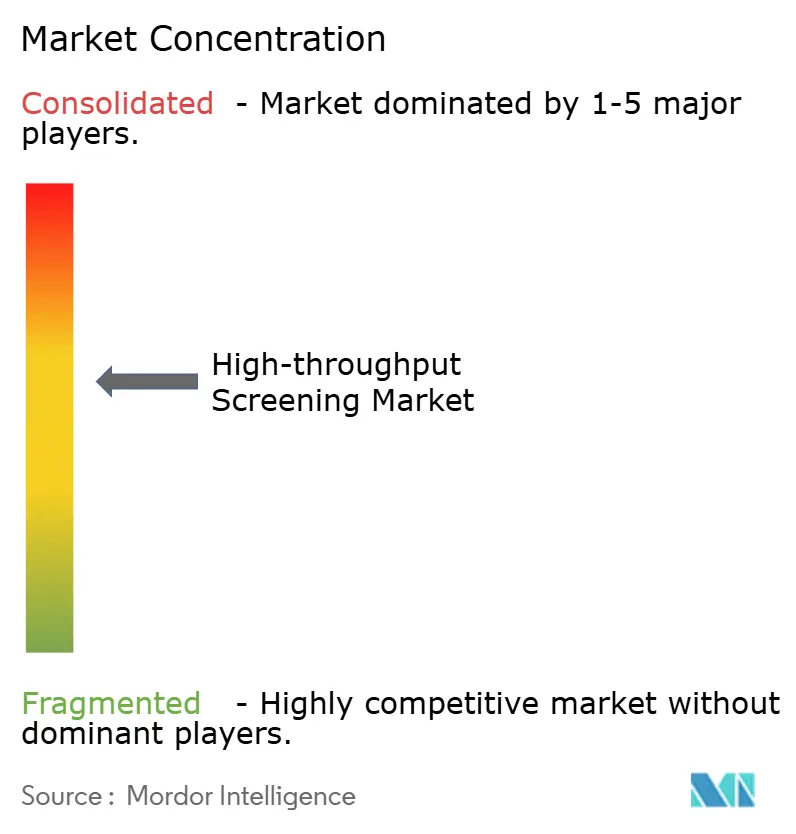
Recent Industry Developments
- June 2025: Barentz acquired China’s Fengli Group to accelerate pharmaceutical growth in Asia-Pacific, leveraging Fengli’s customer network and technical expertise.
- May 2025: Applied Industrial Technologies finalized the acquisition of IRIS Factory Automation, adding automation products and services for material-handling and traceability workflows.
- February 2025: MyHub closed an additional KRW 4.5 billion (USD 3.4 million) Series A round, elevating total funding to KRW 10 billion (USD 7.6 million) for its medical-AI platform adopted by 500+ Korean institutions.
- January 2025: Recursion Pharmaceuticals advanced two AI-discovered oncology candidates, REC-3565 and REC-4539, into clinical trials scheduled for early 2025.
Research Methodology Framework and Report Scope
Market Definitions and Key Coverage
Our study defines the high-throughput screening (HTS) market as the annual revenue generated by instruments, detection and liquid-handling modules, reagents, assay kits, consumables, software, and specialist services that enable automated, parallel testing of large compound libraries for drug discovery and allied life-science research.
Scope exclusion: Contract research revenues earned from full pre-clinical packages that embed HTS as only one of many workflows are excluded.
Segmentation Overview
- By Technology
- Ultra-high-throughput Screening (uHTS)
- Cell-based Assays
- Lab-on-a-chip / Microfluidics
- Label-free Technologies
- High-content Screening
- By Application
- Target Identification / Validation
- Primary & Secondary Screening
- Toxicology & ADME
- By Product & Service
- Instruments
- Reagents, Kits & Consumables
- Software & Informatics
- Services
- By End-user
- Pharma & Biotech Firms
- Contract Research / CDMOs
- Academic & Research Institutes
- By Geography
- North America
- United States
- Canada
- Mexico
- Europe
- Germany
- United Kingdom
- France
- Italy
- Spain
- Rest of Europe
- Asia-Pacific
- China
- Japan
- India
- Australia
- South Korea
- Rest of Asia-Pacific
- Middle East & Africa
- GCC
- South Africa
- Rest of Middle East & Africa
- South America
- Brazil
- Argentina
- Rest of South America
- North America
Detailed Research Methodology and Data Validation
Primary Research
Analysts interviewed automation engineers at drug makers, procurement leads at contract research and manufacturing organizations, and senior academics running screening cores across North America, Europe, and Asia. These conversations tested desk-research assumptions around typical library size, reagent burn rates, and the shift toward 3-D cell-based assays, allowing us to refine market inputs and stress-test emerging-economy demand signals.
Desk Research
We began with public statistics on global pharmaceutical R&D outlays, NIH and Horizon Europe grant databases, import-export codes for microplate readers, and filing disclosures from listed suppliers. Trade associations such as the International Society for Laboratory Automation and the Japan Bioindustry Association provided adoption benchmarks, while peer-reviewed studies in journals like SLAS Discovery detailed assay throughput norms. Paid intelligence from D&B Hoovers and Dow Jones Factiva sharpened company revenue splits. This list is illustrative; many additional sources guided data collection, validation, and clarification.
Market-Sizing & Forecasting
A top-down build used pharma and biotech R&D spending pools, adjusted by HTS penetration rates and average spend per active screening seat, which are then corroborated with selective bottom-up checks on vendor shipments and prevailing reagent kit prices. Key variables like installed microplate reader base, median compounds screened per day, compound-library expansion, cell-based assay share, and venture investment in microfluidic uHTS platforms influence both the baseline and the growth curve. Multivariate regression, supported by scenario analysis for funding cycles, projects demand through 2030. Gap handling in sparse country data relies on proxy metrics such as clinical-trial density and biotech venture funding.
Data Validation & Update Cycle
Outputs undergo variance checks against independent indicators, followed by multi-analyst review before sign-off. We refresh models annually and trigger interim updates when material events, such as major instrument launches or regulatory shifts, occur. A final pre-publication sweep ensures clients receive the most current view.
Why Mordor's High-throughput Screening Baseline Earns Reliability
Published estimates often differ because firms pick dissimilar scopes, price points, and refresh cadences.
Key gap drivers include whether software and microfluidic platforms are counted, the aggressiveness of assumed assay-price deflation, and how frequently models are revisited. Mordor's analysts lock study scope to core HTS activities only, apply compound-specific ASP progressions validated through interviews, and revisit inputs every twelve months, limiting drift.
Benchmark comparison
| Market Size | Anonymized source | Primary gap driver |
|---|---|---|
| USD 25.71 Bn (2025) | Mordor Intelligence | - |
| USD 28.80 Bn (2024) | Global Consultancy A | Includes peripheral screening services and uses single-stage CAGR from 2019 base year |
| USD 22.71 Bn (2024) | Trade Journal B | Excludes lab-on-chip and software revenues and applies conservative average selling prices updated biennially |
| USD 18.80 Bn (2024) | News Analytics C | Counts only pharmaceutical end-use and omits academic and CRO demand; relies on limited shipment proxies |
In sum, Mordor's disciplined scope selection, dual-path modelling, and frequent refresh cadence provide a balanced, transparent baseline that decision-makers can trace to clear variables and repeat with confidence.
Key Questions Answered in the Report
What is the current value of the high throughput screening market?
The market is valued at USD 25.71 billion in 2025 and is forecast to reach USD 41.31 billion by 2030, growing at a 9.94% CAGR.
Which technology segment dominates the high throughput screening market?
Cell-based assays lead with 45.14% market share in 2024 because of their superior ability to mimic human biology.
Why are CDMOs growing faster than pharmaceutical companies in high throughput screening?
CDMOs grow at a 12.16% CAGR by offering integrated discovery services that let sponsors avoid heavy capital investment and accelerate timelines.
Which region is expected to grow the fastest?
Asia-Pacific is projected to expand at a 14.16% CAGR to 2030, propelled by strong biotech investment and favorable regulatory support.
What is driving adoption of microfluidic and lab-on-a-chip platforms?
These platforms provide physiologically relevant microenvironments, reduce reagent costs, and support sustainable laboratory practices, driving a 10.69% CAGR.
How are AI tools changing high throughput screening?
AI enables in-silico triage that cuts wet-lab library size by up to 80%, improves hit rates, and shortens drug-discovery timelines to under 18 months.
Page last updated on:
